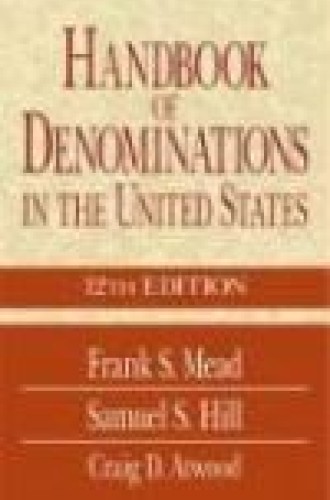Handbook of Denominations in the United States (12th edition)
The Handbook of Denominations has long been a standard reference work for religious professionals. For those of us addicted to the blooming, buzzing confusion of American religion it is more than a reference book. We eagerly anticipate each new edition, and are occasionally so impatient that we contact the editor to offer information and ask questions. For most readers, however, it is simply the best source of information about the 250-some American religious groups in the Abrahamic traditions.
The Handbook first appeared in 1951, when Christian Herald editor Frank Mead produced its inaugural edition for Methodist Publishing House. Since then a new edition has appeared every few years as the plethora of denominations grows and changes. Current editor Craig Atwood (formerly of Salem College and now pastor of a Moravian church in North Carolina) took over from Samuel Hill for the 11th edition, which represented a major change in the Handbook’s structure and scope. As one who has watched the volume’s evolution since the 1970s I can attest that under Atwood it has improved significantly.
The 12th edition makes fascinating reading. Atwood has added new essays and expanded and corrected old ones. Each section begins with a historical sketch of a particular tradition, followed by briefer descriptions of the important church bodies within it. Many of these denominational entries are about small but historically or theologically significant groups. Where but in the Handbook can you find ready and reliable information about the Apostolic Lutheran Church of America (the Laestadians), located mostly where Finnish immigrants settled? Perhaps on the Internet (the Handbook now also includes a Web site address for virtually every listed denomination)—but even Googling a denomination’s name might not get you this information.
The Handbook includes vivid descriptions of Jewish bodies and traditions, including (surely to some Jewish leaders’ dismay because it is under “Judaism”) the Messianic Jewish Alliance of America. Also vivid are the descriptions of Christian and Islamic traditions and of various eclectic religious groups, which are grouped mostly under the category “Esoteric, Spiritualist, and New Thought Bodies.” For the most part, the organization of the 12th edition is clear and helpful, and all in all it represents a vast improvement over earlier ones. Occasionally, however, the organization provokes wonderment. Knowledgeable readers will wonder why the Unity School of Christianity and the Association of Unity Churches (headquartered in Lee’s Summit, Missouri) are placed under “Swedenborgian Churches.” Unity shares New Thought roots with Christian Science and Divine Science, so it belongs under “Esoteric, Spiritualist, and New Thought Bodies.”
Several small Pentecostal bodies are absent and should be included: the mostly Scandinavian Fellowship of Christian Assemblies and the mostly Appalachian Church of God, Mountain Assembly, for example. And why is Windsor Village United Methodist Church (Houston) included at all? As far as one can tell from the Handbook, Windsor Village is a single, though large, congregation. Atwood has chosen to place it under “Methodist Churches,” which includes its parent denomination, the United Methodist Church. That’s quite confusing. The Handbook’s editors should stick to denominations and avoid including single congregations or even loose networks of congregations that have not yet coalesced into firm coalitions. The category “Community and New Paradigm Churches” includes several megachurches that have spawned networks of small imitative but independent congregations; my judgment is that such inclusion is inappropriate in a handbook of denominations.
Of course, the task of categorizing and describing American denominations is a perplexing one. Many denominations are hybrids of two or more religious traditions. And denominations come and go. Atwood is to be applauded for taking on this Herculean task and doing a very good job of it in spite of some continuing problems. Before he became editor, the Handbook included some religious bodies of whose existence I could find no other evidence. He has cleaned that up by dropping them. The organization of the tenth and previous editions was confusing and problematic; Atwood has improved organization a great deal.
To make further improvements, I would omit essays on movements that do not have any concrete denominational structure or congregations. It is unclear whether “Jewish Fundamentalism” is commensurable in structure with, say, Conservative Judaism. And is the Society of Saint Pius X, listed under “Catholic Churches,” a denomination or anything like one? The biggest problem of organization lies in the inclusion of the new category “Community and New Paradigm Churches,” which seems to be a potpourri of megachurches and their satellite congregations. Within this category are Calvary Chapels (conservative, Pentecostal) and the Universal Fellowship of Metropolitan Community Churches (the so-called gay denomination). What do these have in common other than having been founded by Pentecostal ministers?
The Unification Church of the Rev. Sun Myung Moon stands alone at the very end of the book (just before helpful charts of National Association of Evangelicals and National Council of Churches denominational members and their Web sites). Apparently Atwood could not figure out where to place it in his revised taxonomy of religious bodies of the Abrahamic traditions. That’s understandable. But he perhaps tried too hard to force some other groups into categories where they don’t belong. I would remove the Universal Fellowship of Metropolitan Community Churches from its category and let it stand alone; the Jehovah’s Witnesses have too little in common (beyond historical roots) with “Adventist and Sabbatarian (Hebraic) Churches”; and the Quakers have little in common with Anabaptists other than pacifism.
Nevertheless, the 12th edition of the Handbook of Denominations remains an indispensable reference book for every library. I will be looking forward to the release of the 13th edition, as my 12th edition will soon be tattered from much reading and studying.



